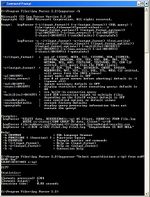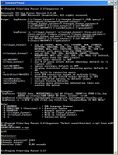The educational technology and digital learning wiki
Jump to navigation
Jump to search
|
|
| Line 1: |
Line 1: |
| {{Data mining and learning analytics tools | | {{Data mining and learning analytics tools |
| |field_logo=Microsoft logo 56x56.png | | |field_logo=Microsoft logo 56x56.png |
| |field_screenshot=logparserScreenShot.jpg | | |field_screenshot=LogparserScreenShot.JPG |
| |field_name=Log Parser | | |field_name=Log Parser |
| |field_developers=Microsoft | | |field_developers=Microsoft |
| Line 17: |
Line 17: |
| |field_data_analysis_objective= | | |field_data_analysis_objective= |
| |field_data_manipulation_type=Data extraction, Data transformation | | |field_data_manipulation_type=Data extraction, Data transformation |
| | |field_data_import=SQL, TSV, XML |
| |field_import_format=TSV | | |field_import_format=TSV |
| | |field_data_export=CHART, SQL |
| |field_export_format=CHART | | |field_export_format=CHART |
| |field_analysis_type= | | |field_analysis_type= |
Revision as of 10:35, 27 February 2014
Log Parser 2.2.10
Developed by: Microsoft
License: Free&Closed source
Web page : Tool homepage
Tool type :
The last edition of this page was on: 2014/02/27
The Completion level of this page is : Low
The last edition of this page was on: 2014/02/27 The Completion level of this page is : Low
SHORT DESCRIPTION
[[has description::logparser is a flexible command line utility that was initially written by Gabriele Giuseppini,[1] a Microsoft employee, to automate tests for IIS logging. It was intended for use with the Windows operating system, and was included with the IIS 6.0 Resource Kit Tools. The default behavior of logparser works like a "data processing pipeline", by taking an SQL expression on the command line, and outputting the lines containing matches for the SQL expression.
Microsoft describes Logparser as a powerful, versatile tool that provides universal query access to text-based data such as log files, XML files and CSV files, as well as key data sources on the Windows operating system such as the Event Log, the Registry, the file system, and Active Directory. The results of the input query can be custom-formatted in text based output, or they can be persisted to more specialty targets like SQL, SYSLOG, or a chart.]]
TOOL CHARACTERISTICS
Usability
Authors of this page consider that this tool is '.
Tool orientation
This tool is designed for general purpose analysis.
Data mining type
This tool is made for '.
Manipulation type
This tool is designed for Data extraction, Data transformation.
IMPORT FORMAT :
SQL, TSV, XML
EXPORT FORMAT :
CHART, SQL
| Tool objective(s) in the field of Learning Sciences |
|
☑ Analysis & Visualisation of data
☑ Predicting student performance
☑ Student modelling
☑ Social Network Analysis (SNA)
☑ Constructing courseware
|
☑ Providing feedback for supporting instructors:
☑ Recommendations for students
☑ Grouping students:
☑ Developing concept maps:
☑ Planning/scheduling/monitoring
☑ Experimentation/observation
|
ABOUT USERS
Tool is suitable for:
Students/Learners/Consumers
Teachers/Tutors/Managers
Researchers
Developers/Designers
Organisations/Institutions/Firms
Others
FREE TEXT
SHORT DESCRIPTION
logparser is a flexible command line utility that was initially written by Gabriele Giuseppini,[1] a Microsoft employee, to automate tests for IIS logging. It was intended for use with the Windows operating system, and was included with the IIS 6.0 Resource Kit Tools. The default behavior of logparser works like a "data processing pipeline", by taking an SQL expression on the command line, and outputting the lines containing matches for the SQL expression.
Microsoft describes Logparser as a powerful, versatile tool that provides universal query access to text-based data such as log files, XML files and CSV files, as well as key data sources on the Windows operating system such as the Event Log, the Registry, the file system, and Active Directory. The results of the input query can be custom-formatted in text based output, or they can be persisted to more specialty targets like SQL, SYSLOG, or a chart.
TOOL CHARACTERISTICS
| Tool orientation |
Data mining type |
Usability |
| This tool is designed for general purpose analysis. |
This tool is designed for . |
Authors of this page consider that this tool is . |
| Data import format |
Data export format |
| SQL, TSV, XML. |
CHART, SQL. |
| Tool objective(s) in the field of Learning Sciences |
|
☑ Analysis & Visualisation of data
☑ Predicting student performance
☑ Student modelling
☑ Social Network Analysis (SNA)
☑ Constructing courseware
|
☑ Providing feedback for supporting instructors:
☑ Recommendations for students
☑ Grouping students:
☑ Developing concept maps:
☑ Planning/scheduling/monitoring
☑ Experimentation/observation
|
Can perform data extraction of type:
Can perform data transformation of type:
Can perform data analysis of type:
Can perform data visualisation of type:
(These visualisations can be interactive and updated in "real time")
ABOUT USER
| Tool is suitable for: |
| Students/Learners/Consumers:☑ |
Teachers/Tutors/Managers:☑ |
Researchers:☑ |
Organisations/Institutions/Firms:☑ |
Others:☑ |
| Required skills: |
| Statistics: |
Programming: |
System administration: |
Data mining models: |
OTHER TOOL INFORMATION

|
| LogparserScreenShot.JPG
|
| Microsoft logo 56x56.png
|
| Log Parser
|
|
|
| Free&Closed source
|
| Microsoft
|
|
|
| 2.2.10
|
| http://www.microsoft.com/en-us/download/details.aspx?id=24659
|
| [[has description::logparser is a flexible command line utility that was initially written by Gabriele Giuseppini,[1] a Microsoft employee, to automate tests for IIS logging. It was intended for use with the Windows operating system, and was included with the IIS 6.0 Resource Kit Tools. The default behavior of logparser works like a "data processing pipeline", by taking an SQL expression on the command line, and outputting the lines containing matches for the SQL expression.
Microsoft describes Logparser as a powerful, versatile tool that provides universal query access to text-based data such as log files, XML files and CSV files, as well as key data sources on the Windows operating system such as the Event Log, the Registry, the file system, and Active Directory. The results of the input query can be custom-formatted in text based output, or they can be persisted to more specialty targets like SQL, SYSLOG, or a chart.]]
|
| General analysis
|
|
|
|
|
|
|
|
|
|
|
|
|
|
|
|
|
|
|
|
|
| Data extraction, Data transformation
|
|
|
|
|
| SQL, TSV, XML
|
| CHART, SQL
|
| TSV
|
| CHART
|
|
|
|
|
|
|
|
|
| Low
|



